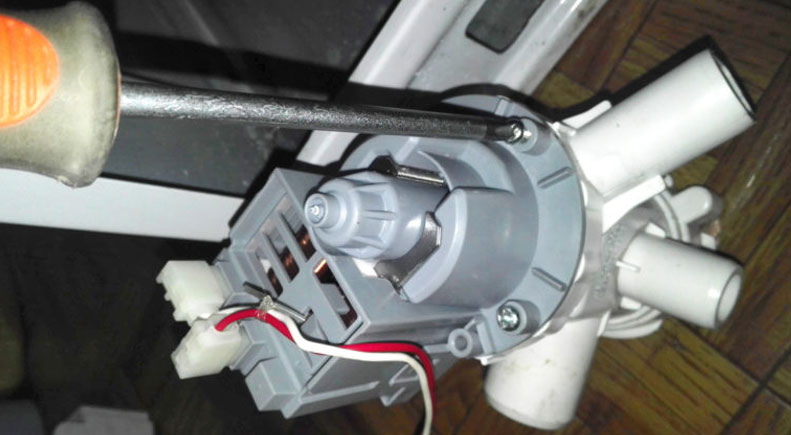Ardo washing machine drain pump change

Drainage is considered one of the most vulnerable parts of washing machines. Constant starting of the machine, long-term operation, lack of preventive cleaning inevitably affect the functioning of the drain. Hoses and mechanisms become clogged, pumping water out of the tank stops, the system displays an error code. Replacing the pump in the Ardo washing machine helps restore the functioning of the drain. When this is necessary and how it is done, we will explain point by point.
Make sure the problem is in the pump.
If problems with drainage are noticed, then there is no need to change the drain pump right away. Sometimes completely different breakdowns and failures lead to disrupted water pumping: from a clogged filter to a “frozen” control board. Each malfunction requires a certain repair, so first it is necessary to “diagnose” the equipment. To do this, we carry out a sequential diagnosis of all elements of the drainage system.
Sometimes it is enough to look at the display or the dashboard as a whole. Modern Ardo machines are equipped with a self-diagnostic system, which allows them to determine the malfunction that has occurred in automatic mode. The board records the failure, displays the error code on the screen or starts the corresponding indication. The user only needs to open the factory instructions and decipher the "emergency" combination.
Without the self-diagnostic system triggering, you will have to act manually - that is, consistently check all possible breakdowns. Let's start with answers to auxiliary questions.
- Is the drain or spin function activated? Some programs do not provide these options or reset user settings by mistake. It is recommended to restart the cycle and check for drainage problems.
- Is the sewerage system installed according to the rules? The drainage hose should be raised above the tank level and lie freely, without kinks or compression.
- Is there an external blockage? The sewer pipe or trap may be clogged. The best way to check is to disconnect the drain hose, lower it into the toilet and start the drain.
If the answer is “yes” everywhere, then the failure occurred inside the washing machine. But it is not a fact that the breakdown concerns the drain pump. More often, the culprit is the garbage filter, which without preventive cleaning gets very clogged and does not let water into the sewer. It is easy to check the guess: remove the false panel of the technical hatch, put a container under the filter and slowly unscrew the nozzle from the “socket”. Thoroughly wash the removed “spiral” from dirt, and at the same time “clean” the seat.
Then we move on and inspect the drain pump and nearby pipes. Perhaps a foreign object is stuck nearby, or the impeller is blocked by hair and debris. It is advisable to try to unscrew the blades on the pump, if this is impossible, you will have to remove the device and diagnose it.
Changing the element with your own hands
Almost every Ardo owner can remove the pump, evaluate its performance and, if necessary, replace it with a new one. The procedure requires a minimum of tools: a multimeter and a screwdriver. You don’t even need to disassemble the machine – just look inside through the bottom. The main thing is to first study the structure of the drainage system and remember safety precautions. To avoid mistakes, follow the instructions below:
- Disconnect the machine from the power supply,
- Shut off the water supply,
- Use the emergency drain or empty the drum by unscrewing the waste filter,
- Place a rolled-up carpet or other soft surface to the left of the washing machine,
- Lower Ardo onto his left side,
- Remove the tray, if there is one on the Ardo,
- Find the drain pump fixed on the snail holder,
- Unscrew the screws holding the pump,
- Release the wiring connected to the device,
- Remove the pump from its seat.
Having removed the pump, we begin diagnostics. First, we inspect the snail and the drainpipe, then the pump itself. The latter must be checked with a multimeter: turn on the ohmmeter, connect the probes to the contacts and evaluate the result. Normally, the device produces about 20-30 Ohms. If the values are lower, the device must be replaced. There is practically no possibility to disassemble and repair the pump - it is too difficult and expensive. It is easier and cheaper to buy a new pump, focusing on the serial number of the washing machine. Ideally, you need to bring the old device to the store and ask to select an analog.
Before installing the pump, thoroughly clean the "nest" from dirt and plaque. Then insert the pump into the grooves, fix it on the snail, return the wiring and pipe. Then put the washing machine vertically, connect and start the test cycle. If the drain is established, everything is done correctly. The absence of drainage even after cleaning the drain and replacing the pump indicates problems with the control board. It is not recommended to deal with the electronic module yourself - it is better to immediately contact the service center.



